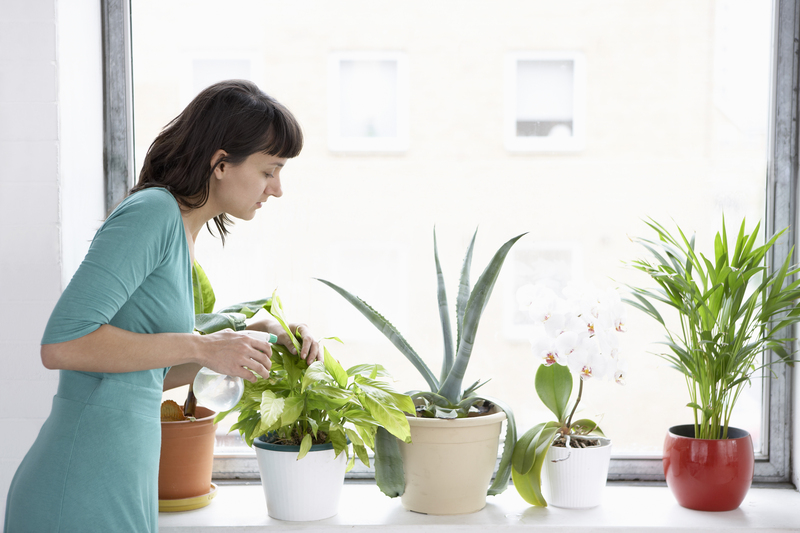Elevate Your Green Thumb with Orchids
Posted on 13/09/2025
Elevate Your Green Thumb with Orchids: The Complete Guide
Orchids have long captivated plant lovers with their mesmerizing blooms and alluring mystique. Whether you're an aspiring gardener or a seasoned plant enthusiast, learning how to elevate your green thumb with orchids can open the door to a world of color, beauty, and botanical satisfaction. In this comprehensive orchid care guide, we'll show you how to grow, nurture, and showcase these remarkable plants in your own home. Ready to embark on your orchid adventure? Let's dive in!
Why Choose Orchids for Your Home?
Many people think orchids are difficult or intimidating to grow. However, with the right knowledge and a bit of practice, they can become one of the most rewarding additions to your indoor garden. Here's why growing orchids at home is a smart choice for anyone looking to elevate their gardening skills:
- Exquisite Blooms: Orchids offer an incredible diversity of colors, shapes, and fragrances.
- Long-Lasting Flowers: Compared to many houseplants, orchids bloom for weeks or even months at a time.
- Year-Round Enjoyment: By picking various types, you can enjoy orchid flowers throughout the year.
- Air-Purifying Qualities: Like other houseplants, orchids help freshen indoor air.
- Conversation Piece: A thriving orchid display always impresses friends and visitors!

Understanding Orchids: A Fascinating Plant Family
The Orchidaceae family contains over 25,000 species worldwide--one of the largest plant families on the planet. Orchids are found everywhere from tropical jungles to alpine meadows. Their blooms come in a stunning spectrum of shapes, colors, and patterns, each with a unique charm.
If you want to truly master the art of orchid growing, it's helpful to know the basics about the most popular orchid types for home growers:
1. Phalaenopsis (Moth Orchids)
These are the most common orchids for beginners. Their elegant, arching sprays of blooms resemble butterflies or moths and can last for months with proper care.
2. Cattleya
Known for their large, fragrant, often ruffled flowers, Cattleyas are popular with collectors and exhibition growers. Their vibrant blossoms are a true feast for the eyes.
3. Dendrobium
This group offers a wide range of form and size. Some Dendrobiums are exceptionally easy to grow and highly productive, rewarding your efforts with cascades of dazzling flowers.
4. Oncidium (Dancing Lady Orchids)
Named for their resemblance to a dancing lady, Oncidiums produce sprays of tiny, fragrant flowers--often yellow and brown--that can brighten up any shelf or windowsill.
10 Expert Tips to Elevate Your Green Thumb with Orchids
Successfully elevating your green thumb with orchids is all about understanding their needs and providing the ideal conditions. Here are ten proven strategies to help your orchids flourish:
- Select the Right Orchid Species: Start with beginner-friendly varieties such as Phalaenopsis or Dendrobium.
- Light Matters: Most orchids prefer bright, indirect light. An east- or north-facing window is ideal. Too much direct sunlight can scorch leaves, while too little light stunts growth and stops blooming.
- Keep Humidity High: Orchids thrive in moist air. Increase humidity with trays of pebbles and water or use a room humidifier.
- Don't Overwater: This is the number one mistake! Let the potting medium dry out slightly between waterings. Watering once a week is usually enough.
- Humidity Trays for Happy Roots: Place your pots above trays filled with water and pebbles (not touching the water) to boost local humidity and protect roots from sitting in water.
- Special Orchid Potting Mix: Never use regular soil. Orchids need a fast-draining mix, usually made of bark nuggets, sphagnum moss, and perlite, to mimic their natural environment.
- Feed Wisely: Use a balanced orchid fertilizer at half-strength every two to four weeks while plants are growing and flowering.
- Encourage Air Circulation: Orchids love fresh air! Place them near an open window or use a small fan to prevent stagnant conditions and the build-up of pests and mildew.
- Repot Every 1-2 Years: As orchids outgrow their containers and potting mix breaks down, repotting revitalizes their root system.
- Be Patient: Sometimes, orchids need to rest. If your plant is not blooming, review its care and give it time--next season could bring an explosion of color!
Potting and Repotting Orchids: Step-by-Step
Orchid potting differs from other houseplants. Since most orchids are epiphytes (they grow attached to trees, not in soil), it's essential to mimic those conditions. Here's how:
How to Pot Your Orchid
- Choose the Right Pot: Clear plastic pots with drainage holes are perfect for orchids, letting light reach roots and excess water drain out.
- Use Orchid Mix: Fill the pot about halfway with your chosen bark-based orchid planting medium.
- Gently Remove Old Medium: Carefully take the orchid out of its old pot, shaking free any clinging potting mix.
- Trim Damaged Roots: Using sterilized scissors, snip off any dead or mushy roots.
- Center the Plant: Place the orchid in the new pot so roots fit snugly, then fill gaps with fresh mix, pressing gently.
- Water Lightly: Moisten the medium but avoid soaking it completely.
The Orchid Care Calendar
Keeping your orchids thriving year-round means adjusting care routines with the seasons. Here's a calendar to help you:
- Spring: Increase watering and feeding as new leaves and roots appear. Repot if necessary. Watch for pests as temperatures rise.
- Summer: Keep humidity high and protect from harsh, direct sun. Water more frequently if the room gets hot.
- Autumn: Reduce fertilizer as growth slows. Begin adjusting watering if temperatures cool and days shorten.
- Winter: Cut back on watering and let the plant rest. Give as much light as possible--consider supplemental grow lights if natural sunlight is scarce.
Unlocking Orchid Blooms: Secrets to Flowering Success
The joy of orchid cultivation is those unforgettable blooms. Here's how to trigger flowering and keep the display going:
- Temperature Fluctuations: Many orchids bloom after experiencing a slight drop in night-time temperature (5-10?F lower than during the day).
- Sufficient Light: If orchids aren't blooming, increase filtered light gradually and watch for deeper green leaves, which signal too little light.
- Consistent Feeding: Regular, diluted fertilizer supports healthy flower production.
- Seasonal Rest: Some varieties, especially Dendrobiums, need a rest period with less water and feeding to trigger their floral display.
Tip: After blooms fade, cut the flower stalk just above a node to encourage re-blooming on many types, especially Phalaenopsis!
Dealing with Orchid Pests and Problems
Healthy orchids are robust and resilient, but they can sometimes fall victim to common orchid pests or diseases. Here's how to handle them effectively:
- Aphids and scale: Wipe leaves with a soft, damp cloth or spray with insecticidal soap.
- Spider mites: Increase humidity and rinse leaves under water.
- Root rot: Usually caused by overwatering. Remove affected roots and repot in fresh medium.
- Yellow leaves: Often due to too much sunlight or nutrient deficiency--adjust care and feeding accordingly.
- Mealybugs: Dab pests with rubbing alcohol using a cotton swab for spot treatment.
Prevent disease by ensuring good air flow, avoiding crowded conditions, and checking crops regularly for early signs of trouble.
Showcasing Your Orchids: Display Ideas for Every Home
Once your orchids are thriving, display them creatively to highlight your expanded green thumb prowess:
- Windowsill Gardens: Line up pots along a bright window for a cheerful indoor orchid display.
- Hanging Baskets: Some orchids flourish in hanging displays, especially Vandas and some Dendrobiums.
- Orchid Terrariums: Group miniature orchids with ferns and mosses in glass containers for a touch of the tropics.
- Living Walls: Attach mounted orchids to a vertical structure for eye-catching, space-saving blooms.
- Tabletop Arrangements: Accent your dining or coffee table with a single, stunning specimen in a decorative pot.
Advanced Green Thumb: Propagating Orchids at Home
Ready to take your skills up a notch? Orchid propagation is both a science and an art. The most accessible methods for home growers are:
- Division: When repotting sympodial orchids (Cattleya, Dendrobium), split the clump into sections, each with at least 3-4 healthy pseudobulbs.
- Keikis: Some orchids, especially Phalaenopsis and Dendrobium, sometimes grow baby plants (keikis) on their flower stems. Once roots are a few inches long, carefully remove and pot them up.
- Backbulbs: Older, leafless pseudobulbs may sprout new growth when set in a humid environment. This is mostly used for experienced growers.
With time and patience, you'll soon be sharing your own homegrown orchid babies with friends and family!
Frequently Asked Questions: Elevate Your Green Thumb with Orchids
- Do orchids really rebloom?
Yes! With the right care, many orchids bloom yearly or even more frequently. Keep nurturing your plant, and it will reward you! - Are orchids poisonous to pets?
Most commonly grown orchids, like Phalaenopsis, are non-toxic to cats and dogs. Always double-check before introducing new plants. - How do I know if my orchid needs repotting?
If roots are spilling over the pot, the potting mix is breaking down, or you see poor drainage or root rot, it's time to repot. - Why are my orchid's leaves wrinkled or limp?
Usually caused by underwatering or root rot. Check the roots and adjust watering.

Conclusion: Start Your Orchid Adventure
Elevating your green thumb with orchids is a deeply satisfying journey. Not only do orchids reward you with stunning, unforgettable blooms, but they also help you develop advanced horticultural skills, patience, and a keen eye for plant care. Whether you're growing classic Phalaenopsis or experimenting with rare species, these botanical wonders will add elegance and beauty to your home for years to come.
Ready to embark on your own orchid-growing adventure? Invest in a few hardy starter orchids, use the tips above, and watch as your green thumb flourishes like never before!
Further Resources: Expand Your Orchid Knowledge
- American Orchid Society - Care guides, videos, and expert advice.
- Royal Horticultural Society: Orchids - UK-based care instructions and orchid identification.
- Orchid Web - Buy orchids and growing supplies online.
Have questions or want to share your success? Comment below with your favorite orchid tips, stories, or photos. Let's continue to grow and inspire together!

